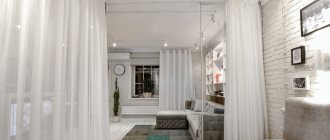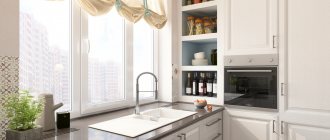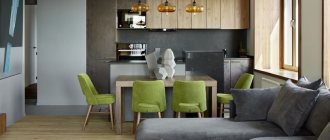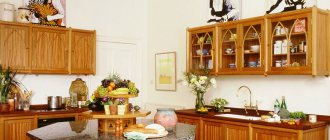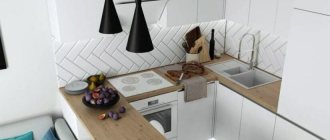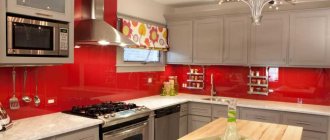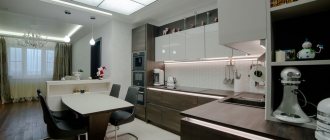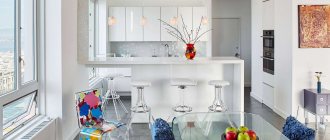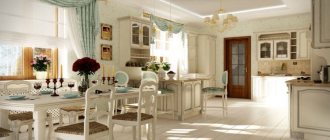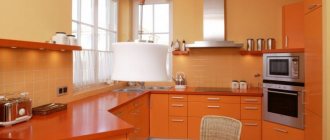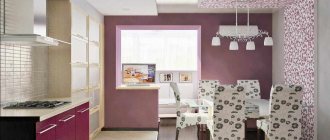When choosing window decoration for a kitchen space, it is important to take into account not only the style of interior design, but also the features of the microclimate of the room. Choosing curtains for the kitchen is a difficult task, requiring a detailed study of the performance properties of different fabrics and methods of decorating them.
Curtains in the dining area serve numerous utilitarian and aesthetic purposes. Beautifully designed pieces of airy fabrics protect the room from direct sunlight, prying eyes of passers-by, street dust and litter. The choice of curtains for the kitchen should be made at the final stage of interior design. In combination with furniture and decoration, it should create a pleasant environment for cooking, family dinners, and gatherings with friends.
Factors influencing the choice of curtains for the kitchen
Incredibly delicate tulles made from light fabrics look organically in the interior of a room for preparing food and dining. They do not block the view of the window opening, which can have an elegant round or intricate asymmetrical shape. The view from the window is clearly visible through the transparent draperies. In combination with curtains, blinds and cornices, they create an interior composition united by uniform features.
Light curtains look organically in the interior
Looking through photos of curtains for the kitchen, it is extremely difficult to make a choice. The abundance of classic snow-white curtains and non-standard curtains decorated with multi-colored patterns opens up endless possibilities for window design . In the process of selecting window treatments for a kitchen, you need to take into account many factors that negatively affect their appearance:
- A high degree of humidity does not allow the use of thick curtains. If the fabric is constantly kept wet, there is a high probability of mold and pathogens forming.
- Regular temperature fluctuations negatively affect the structure of the fabric and the shape of the curtain.
- The absorption of surrounding food odors contributes to repeated washing, as a result of which openwork fabrics quickly fade and become deformed.
- There is a high probability of contamination if it is close to the stove. Oily stains are extremely difficult to remove from snow-white fabrics.
- Due to constant exposure to ultraviolet radiation, curtains quickly fade and lose their original color. Therefore, it is not recommended to choose bright colors unless the use of blinds or window Roman shades is provided.
- If curtains and stoves are located close together, preference should be given to specialized fabrics with impregnation that resists fire.
Curtains must match the kitchen design
There is no unanimous answer to the question “which curtain to choose for the kitchen”. It must comply with the chosen design concept and have impeccable wear resistance.
Short tulle in the living room
This room is intended for family celebrations and friendly meetings. Therefore, this space is given the closest attention in the field of design and creating an extraordinary atmosphere.
Modern designers offer short tulle for decorating windows in the living room. The main thing to consider is the features of this attribute:
- Harmony with interior elements;
- Matching a specific color palette;
- Features of the material used;
- Availability of various accessories;
- Window type;
- Internal lighting of the room and lighting from the street;
- Possibility of combining types of fabric.
Short tulle will look great on a horizontal window, in small rooms, surrounded by Provence, Country, and Classic styles. One nuance that cannot be neglected is that there should not be a radiator under the window.
Criteria for choosing curtains for the kitchen
When choosing a drapery option for a window in the kitchen, you should focus on its purpose, the geometry of the room and its role in the interior picture:
- If the curtain needs to protect the surrounding space from the sun and the prying glances of passers-by, then it is wise to choose a two-layer model or one made from tightly woven fabric. Curtains made of light translucent fabrics at night are not able to hide the appearance of the interior of housing on the lower floors. Therefore, it is recommended to use curtains in tandem with roller shutters or blinds.
Thick curtains will protect the space from the sun
- When using window decoration exclusively for decorative purposes, it is advisable to create harmonious combinations with surrounding textiles and furniture upholstery. The connecting link can be the color scheme, finishing style or fabric texture.
- If the room is located on the north side of the house, where the sun's rays rarely enter the window, it is rational to hang curtains made of weightless fabrics with a high ability to transmit light - organza, veils, lace, muslin.
- If in the interior composition the window should be the center of everyone's attention, then you should consider multi-layered, elegantly decorated and multi-colored drapery options.
Curtains made of weightless fabrics for windows on the north side
If you are in doubt about choosing curtains for your kitchen, a photo gallery with examples of effective window decoration will help you decide on the ideal option.
Material
Durability and design depend on which material is chosen. However, there is another important parameter here - strength. Not all curtain rods can withstand heavy tapestry or blackout fabric.
- Wood (walnut, oak, cherry, pine, linden) is an unfading classic. Wood is used to make simple tubular structures and elegant baguettes. They are strong and durable, but in the kitchen, due to humidity and temperature changes, they quickly lose their appearance: they swell and crack. It is worth considering that valuable wood species will not be cheap.
- Metal (stainless, chrome-plated or nickel-plated steel, aluminum, copper, brass) - can withstand high loads. Any type of object is made from metal in a variety of stylistic directions. The only negative is the price.
- Plastic (polyvinyl chloride) is the most budget category. Such products are often “disguised” as more noble wood and metal. This allows you to get the same look at a more affordable price. However, it is worth paying special attention to the safety class of the product and checking all documentation. Otherwise, there is a risk of buying a low-quality product that will release toxic fumes into the air. In addition, such models are not intended for heavy curtains - the plastic may break.
How to determine the optimal length and width of curtains for the kitchen
The length of the window decoration in the dining room is influenced by the location of the opening:
- With a linear layout of a narrow kitchen with a window located on an empty wall, it is reasonable to offset the disadvantage with the help of a voluminous curtain to the floor with numerous folds.
A voluminous curtain to the floor will visually enlarge the window
- With panoramic glazing, it is appropriate to opt for barely noticeable products made of mesh or transparent fabric with floor length. It is important to frame small windows with short arched curtains.
- When placing a sink close to the practical side, you should give preference to short arched models or those assembled along the edge using decorative clips. Curly curtains with an edge decorated with lace braid, frill in the form of fringe, ornate patterns embroidered with bright threads look elegant.
Short curtains for the window above the sink
- If you plan to organize a dining area next to the opening, then ideally decorate the window with a short transparent curtain with an arched cutout. In this design, the curtain will not interfere with admiring the view from the window.
The type of window decoration depends on the width of the tulle. Thin rectilinear canvases corresponding to the width of the cornice look laconic, emphasizing the minimalist style of kitchen interior design. The window frames are clearly visible through them. Therefore, to express their interesting architectural form, it is important to choose similar curtains from transparent fabrics.
Thin curtains highlight a minimalist kitchen design
If the window is located on the accent wall of the kitchen, it is optimal to opt for a multi-layer option. Numerous soft folds of drapery will be obtained with a curtain width twice as large as the opening. To form frequently repeating fabric gathers, it is advisable to use specialized curtain tape.
Advantages of short tulle
The advantages include arguments such as:
- Free approach to the windowsill;
- Light weight, making it possible to attach tulle to fairly light cornices;
- Basic care;
- Compression when placed in a window opening.
In small kitchens, the window sill can serve as a countertop or play the role of a compact table. Short tulle does not interfere with these decisions.
Expert recommendations:
- Small curtains and short tulle allow for effective use of the part of the wall that surrounds the window opening.
- It becomes possible to visually change the present proportions of space.
- Such tulle plays the role of a characteristic cursor of some styles.
Don't be afraid to experiment with window design. All attempts will certainly be crowned with success and will bring novelty, grace and individuality to the interior.
Modeling the kitchen space using curtains
The configuration of the room and the height of the ceiling affect the parameters of the tulle or curtain. In low rooms, it is optimal to use drapery with a length from ceiling to floor to visually change the space. It is easy to visually stretch out a room when decorating a window with a curtain with alternating transparent and dense, plain and colorful vertical stripes. It is easy to level out the excessive height of the kitchen with a similar design with horizontal coloring or typically placed ornaments.
Curtains with alternating colors increase the height of the ceiling
The size of the room and window opening dictates its own rules for choosing curtains for the kitchen. Dark canvases shade the room well, but significantly narrow its boundaries due to insufficient lighting. Transparent lace products perfectly transmit light, illuminating the room with sunlight. In this design, even a miniature kitchen seems spacious and cozy.
Light curtains fill the kitchen with sunshine
If the kitchen has access to a balcony, then it is wise to hang a curtain with a diagonal frame or tieback of the appropriate shape. With this design, it will not get dirty due to free access to the door of the window unit.
When functionally using a window sill or the area under it as a storage system, it is wise to hang short and practical tulles with a figured neckline or gathered at the edges. A similar window drapery in the kitchen should be done if beautiful compositions of indoor flowers are placed on it or pots are hung on it.
Short curtains allow you to use the space under the window
To dress up a window, just choose a massive cornice with decorative finials and hang light multi-layer curtains in the kitchen. The design of products with pronounced patterns in a color different from the base attracts the attention of others. Plain models dissolve against the general background of the window.
Types of curtain rods by mounting method
All fastenings are divided into two large groups - wall and ceiling. Let's figure out how to attach cornices, weigh the pros and cons for each option.
| View | What is this | Advantages | Flaws |
| Wall mounted | Designs for wall mounting. They consist of brackets and strips for hanging canvases. | 1. Models in any style. 2. Easy installation. 3. Options for light and heavy curtains. | 1. Large load for plasterboard walls. 2. Partial transmission of sunlight through the rods. |
| Ceiling | Structures that need to be fixed to the ceiling | 1. Visually raise the ceilings. 2. Help to disguise wide window sills. | 1. Difficulties when installing on a ready-made stretch ceiling. 2. Small variety of design options. |
Important! You should not use traditional cornices for a suspended ceiling. The canvas may not withstand the load.
Ceiling curtain rod for bay windows
Wall mounted metal curtain rod
Choice of colors
The color of kitchen curtains occupies an important place in the interior composition:
- personifies the stylistic genre used to decorate the space;
- visually adjusts the appearance and shape of the window;
- places bright accents on the interior picture;
- hides imperfections in a window frame or sill;
- complements the look of surrounding textile furnishings;
- affects the tonality of the colors of design elements.
Bright curtains will add color accents
When choosing the color of fabric for sewing curtains, you should remember several color rules:
- If the walls are decorated with multi-colored wallpaper or multifaceted textured paint, then the curtains should be light with discreet decor. Colorfully decorated curtains will merge with the colored background and form a multicolor chaos, scattering and tiring the eye.
- When covering walls in a single color with a calm color scheme, it is wise to complement the window space with drapery in a rich tone. Mint, orange, soft pink, turquoise, olive curtains will fill the kitchen space with the bright colors of summer.
Drapery in rich colors with plain wall decoration
- Excessively saturated fabric colors quickly become boring, tiresome and cause aggression. Such draperies are inappropriate in the kitchen, since in most homes this room has a small area.
- In large rooms it is worth combining colorful narrow curtains with elegant curtains in pastel colors.
- Large patterns of expressive colors on kitchen curtains visually reduce the perception of the size of the room.
- Snow-white, pastel colors, gradations of blue and green promote relaxation during meals or tea parties.
Pastel colors promote relaxation
Bored curtains in dynamic colors need to be replaced with new tulles in calm tones. In contrast, boring plain curtains can be modified, giving them features of originality through decoration with lush tassels, openwork borders of bright colors, embroidery with colorful threads, scallops, colorful clips or brooches in the form of fluttering butterflies. Photos of curtains in the kitchen with a variety of decor will inspire you to select a model that perfectly matches the color of the interior, capable of flawlessly complementing and enlivening the familiar environment.
Curtain decor with lush tassels
Pros of short tulle
The advantages of short tulle are obvious:
- Small waste of fabric.
- Accordingly, financial costs are lower.
- Short tulle is easier to care for.
- Visually expands the space.
- The window sill is successfully used for arranging indoor flowers.
- The use of drapery, the use of various types of decorative materials, decorative components and accessories.
In order not to disturb the sophistication of this item, you should always take into account the dimensions of the room, style and lighting.
Choosing fabric for sewing kitchen curtains
Depending on the desired decorative effect produced by the curtains in the dining room, it is necessary to select the appropriate fabrics:
- Weightless draperies that fill the kitchen with solar warmth, light and air are made from semi- and transparent textile bases - tulle, organza, tulle and micro-voile. Multilayer lambrequins are often used to frame them.
Multilayer curtains for the kitchen
- Dense window decorations made of chiffon and cambric reliably protect surrounding furnishings and decorations from fading. They look advantageous in tandem with silver or gold eyelets, organically combined with the typical color of the cornice.
- Curtains made from natural fabrics - silk, cotton, linen - look inimitable. They have incomparable performance properties - moisture resistance, breathability, wear resistance.
Curtains made from natural fabrics are wear-resistant
- The only drawback is the difficulty of care. They easily absorb odors and wrinkle a lot during washing, even on a delicate cycle.
- Polyester, synthetics and other artificial fabrics can be easily washed, dry quickly, practically do not wrinkle, but instantly ignite when exposed to fire.
- Incredibly soft chiffon and tulle allow you to create neat-looking pleats. Flowing pleats along the window can be arranged anywhere in the window and at the desired height.
Lightweight tulle creates neat-looking pleats
- Exquisitely decorated sections of rigid organza, jacquard and tulle create voluminous folds that require freedom. Therefore, they are suitable for draping large openings in spacious kitchens.
Having learned about the performance characteristics and decorative capabilities of fabrics, you can independently sew unique curtains for the kitchen. Photo instructions from skilled needlewomen will help you create a beautiful window dressing with an exclusive look.
Control
If it is expected that the curtains will need to be opened and closed quite often, then the control method becomes an important selection factor.
It is important that during movement the material moves freely along the cornice without clinging to anything. Otherwise, due to excessive force, there is a risk of tearing the fabric or breaking the structure.
- Manual - you will have to manually pull back the curtains and also manually close them.
- Mechanical - textiles begin to move when some mechanism is activated. For example, you need to pull a chain or turn a cane.
- Electronic – position control is carried out via a remote control. This is especially convenient if you need to open a large number of curtains at once.
Decorative possibilities of curtain tapes in the design of kitchen curtains
From the same curtain you can get completely different window drapes in the kitchen. Using different types of curtain tapes, you can endlessly experiment with curtain designs :
- The top braid in the form of columns or pencils will form rectilinear and narrow gatherings of fabric that perfectly repeat each other.
Braid in the form of columns
- Ruffle puffs create chaotically folded folds.
Ruffle puffs create chaotic folds
- Ribbons-bows, sewn on the reverse side of the curtains, give the appearance of lush decorative elements of the same name.
- The fan braid helps to create multi-layer folds with 4-5 folds of fabric at a certain distance from each other, similar to French curtains.
Fan braid for decorating multi-layer folds
- The lining in the shape of glasses creates a voluminous gathering, transitioning from a wide fold to a narrow one.
- The frill, which creates the effect of overlapping folds on each other, forms double gathers of the fabric.
“Glass” braid creates a voluminous gather
When tightening the cords of curtain tapes, you need to maintain the proportionality of the drapery: evenly distribute the folds of fabric across the entire width of the curtain.
Due to the variety of textile accessories, you can achieve a unique design of curtains for the kitchen. Photos of variations in curtain decoration will allow you to examine in detail the original examples of fabric design.
Using the shape of the folds on the tulle, it will be possible to emphasize the geometric outlines of adjacent furnishings - rounded or curved outlines of furniture fronts, diamond-shaped capitonné screed on soft kitchen corners or leather sofas.
The shapes of the folds of the curtains emphasize the geometric shapes
Neither elegant airy curtains, nor pompous-looking multi-layered pleated curtains, even silk tulle shiny in the light with woven shiny threads are capable of making a greater impression on others than lighting. It can be used to decorate a cornice, obtaining a mesmerizing effect of iridescent and shimmering light and shade on the bends of the fabric. This design solution will emphasize the recognition of modern interior fashion trends. In addition, in a cheerful kitchen environment with rainbow tints on the curtains, you can organize cocktail parties and intimate conversations during evening meals.
The choice of curtains for the kitchen must comply with the canons of the chosen design style. Classic interiors of dining areas are unthinkable without luxurious draperies with elite fabrics. It is difficult to imagine Art Deco and Baroque without multi-layered wavy window decorations with festoons, visually reminiscent of a theatrical setting. Country and rustic accepts simplicity and naturalness without unnecessary decorative frills.
Curtains for the kitchen in a classic style
A window in any room takes up most of one of the walls. Therefore, its decor needs to be given special significance. Properly selected or independently created curtains for the kitchen will make the interior design unique and complete.
Functionality
Curtains and curtains used to decorate window openings perform several important functions:
- are an important element of the decor and style of the room;
- protect furniture from direct sunlight and rapid fading;
- protect the privacy of the owners of a house or apartment from prying eyes;
- help hide the shortcomings of the room, or emphasize its advantages;
- create a cozy, homely or formal atmosphere.
Types of curtains for curtains:
- Classic. As a rule, they are combined with straight sliding curtains in the interior of bedrooms and living rooms. If used independently, they are decorated with lambrequins and various types of draperies, and also decorated with accessories.
- French classic. Curtains decorated with lush festoons.
- Austrian style. This is a classic interior that has horizontal crescent-shaped scallops and twisted decorative cords with large tassels.
- Curtain panels in Japanese style. They are made from straight individual sheets that move freely along the cornice. 3-4 canvases are used for one window opening.
- Panel curtains. They are an indispensable component of the Art Nouveau style. They are made from strict fabrics that have a rich and beautiful appearance.
- Rolled. Mounted on a special cornice. Suitable for interiors designed in different stylistic directions.
- Roman. These are separate canvases that are distinguished by strict geometry, simplicity and functionality. Suitable for decorating living spaces and kitchens.
- Pleated curtains. They are made of corrugated materials and are used for draping windows of non-standard configurations. Suitable for both living rooms and office spaces.
- Curtains attached to eyelets. Steel or plastic rings are installed at the top of the curtains, the cornice is threaded through them, which makes it possible to move the curtains freely and create beautiful vertical folds on them.
- Bamboo types of curtains. They are made from thin bamboo sticks that are sewn by hand. Perfectly complement the interior of sunny rooms, attics, terraces and protect from the scorching rays of the sun.
Photo gallery - curtains for the kitchen
Additional accessories
Accessories can add charm and increase the practicality of window decoration.
- Rings and eyelets - if you choose one of these fastening options, then the parts themselves must be combined with the cornice. It is desirable that they be made of the same or similar material with a similar color. Although in some cases it is appropriate to use a contrasting shade.
- Magnetic clips - they are installed as an alternative to loops, eyelets, hooks and other types of holders. They are convenient because you do not need to additionally process the edge of the curtain.
- Fleurons are decorative tips on tubular samples. They have a variety of shapes, from the simplest nondescript plugs to forged openwork elements with decorations.
Brackets
Please note that the brackets vary in length. If the length exceeds the distance from the window to the ceiling, then it will not be possible to place the bracket above the window opening - it simply will not fit. In such a situation, they can be placed below the window. This option is called placement “partially above the window opening.”
Important! A cornice over two meters long must be mounted on three brackets. If the length is less than two meters, two will be enough.
The distance between fastenings must be at least one and a half meters and should not exceed two meters. Then the cornice will be securely fastened: this will help avoid deformation and the curtains will not sag.
Installation features
When attaching cornices, general recommendations are taken into account:
- The curtain should cover the window by 15-40 cm on each side. This makes it possible to open the curtains as much as possible and let sunlight into the room.
- When placing the cornice, the projections on both sides of the window should be the same.
- The distance from the wall is selected so that the curtains do not touch the window sill and the heating radiator.
- Curtains that cover the entire surface of the wall should be 1-2 cm smaller than its length.
Principle of installation of wall-mounted models
- The cornices are fixed above the opening at a distance from the ceiling equal to 1/3 of the width of the beam above the window.
- Using a level and tape measure, the attachment points are determined in accordance with general recommendations.
- To prevent the long rod from bending under the weight of heavy curtains, fastening elements are installed every 1.5-2 m.
- The brackets are screwed with self-tapping screws through pre-fixed dowels.
- Rings are put on the bar and it is fixed to the wall.
- Tips are installed.
Rules for attaching ceiling cornices
- First, preliminary assembly of all structural parts is carried out.
- The assembled cornice is applied to the ceiling, the attachment points are marked with a pencil. Ceiling rails are attached every 30-50 cm, following general recommendations.
- Holes are drilled in the concrete floor and dowels are inserted.
- When installing a plasterboard ceiling at the installation sites, it is necessary to provide for mortgages in advance. The gypsum board will not support the weight of the cornice with curtains, so it is attached to a wooden block that serves as an intermediate support. The mortgages, in turn, are securely screwed to the concrete base using self-tapping screws and dowels.
- When installing a cornice on a suspended ceiling, a similar fastening method is used - wooden mortgages are also provided on which the entire structure is fixed. Additionally, special rings are installed in the tension fabric at the points where the self-tapping screws will pass, which prevent the PVC film from tearing under the load.
- When designing a stretch ceiling, you can take into account the location of the cornice and leave a niche for it, without bringing the canvas to the wall with the window. Then the fastening will be quite easy and the curtain will be hidden in the created space.
Photo printing
This is one of the newest methods of drawing and is already widely popular among experienced designers and housewives.
There are two types of photo printing depending on the method of its application:
- Thermal printing. A certain coating is first applied to the fabric, and then a pattern is applied using a heated device.
- Ultraviolet printing. The paint is applied using string elements while simultaneously exposing the patterned curtain fabric to ultraviolet radiation.
In many ways, photo printing dominates over other methods of drawing. In particular, these are wear resistance and low cost of such products.
